Physical Address
304 North Cardinal St.
Dorchester Center, MA 02124
The purpose of this chapter is to review lesions involving the trachea and proximal bronchi, to describe the radiological signs of bronchiectasis and to discuss the role of imaging in obstructive lung disease, a group of diffuse lung diseases associated with chronic airflow obstruction that includes chronic obstructive pulmonary disease (COPD), asthma, and obliterative bronchiolitis. In obstructive lung disease, decreased expiratory flow may be related to loss of lung recoil or small airway obstruction or a combination of both. The most common abnormality correlated with loss of recoil is emphysema. The process that causes the small airway obstruction is inflammatory in nature and is characterised by thickening of all the layers of the bronchiolar walls as well as an accumulation of mucus in the airway lumen (COPD and asthma), and/or an irreversible fibrosis (COPD and obliterative bronchiolitis).
The trachea may be affected by a variety of extrinsic or intrinsic processes. Extrinsic processes, particularly masses, displace and distort the trachea, while intrinsic ones cause narrowing, widening, or a mass effect. Tracheal narrowing may affect a short or a long segment and may extend to the mainstem bronchi. Tracheal disease, though commonly missed on the chest radiography, is usually evident on careful evaluation of the frontal and lateral radiograph. Computed tomography (CT) allows precise delineation of the intratracheal and extratracheal extent of the abnormality. Multidetector CT, by combining helical volumetric CT acquisition and thin collimation during a single breath hold, provides an accurate assessment of proximal airways, allowing multiplanar reformations and 3D rendering of very high quality. Complementary CT acquisition at suspended or continuous expiration demonstrates tracheal collapsibility. This expiratory acquisition may be performed at reduced dose or even better at ultra-low dose, by using thin slices reconstructed with iterative reconstruction or a soft kernel when using filtered back projection mode ( Box 6.1 ).
In tracheal disorders, multiplanar reformations after MDCT acquisition at full inspiration help assess:
the site, length and degree of luminal narrowing,
the site, degree and extent of wall thickening,
the regular, irregular or nodular appearance of the inner surface of tracheal lumen.
Strictures of the trachea are usually secondary to damage from a cuffed endotracheal or tracheostomy tube or to external neck trauma. The lesions consist of granulation tissue followed by the development of dense mucosal and submucosal fibrosis associated with the distortion of cartilage plates. The two principal sites of stenosis following intubation or tracheostomy tube are at the stoma or at the level of the endotracheal or tracheostomy tube balloon.
On radiographs, the stenosis may be seen as a focus of circumferential or eccentric narrowing associated with a segment of increased soft tissue. The size of the narrowing is usually easily seen at CT. The narrowing is often concentric. Post-intubation stenosis can extend for several centimetres and typically involves trachea above the level of the thoracic inlet. Post-tracheostomy stenosis typically begins 1 to 1.5 cm distal to the inferior margin of the tracheostomy stoma and involves 1.5 to 2.5 cm of tracheal wall. Multiplanar reformations are particularly helpful in defining accurately the site, the length and the degree of the stenosis ( Fig. 6.1 ). In selected cases, the degree of stenosis may also be shown by virtual bronchoscopy.
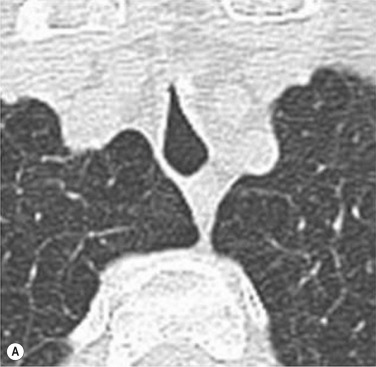
A number of infections, both acute and more often chronic, may affect the trachea and proximal bronchi, resulting in both focal and diffuse airway disease. Subsequent fibrosis may result in localised airway narrowing. The most common causes of infectious tracheobronchitis are bacterial tracheitis in immunocompromised patients ( Fig. 6.2 ), tuberculosis, rhinoscleroma (Klebsiella rhinoscleromatis), and necrotising invasive aspergillosis. On CT, the extent of irregular and sometimes circumferential tracheobronchial narrowing is clearly demonstrated, and in some patients an accompanying mediastinitis (opacification of the mediastinal fat) is evident. In active disease, the narrowed trachea and frequently one or more main bronchus have an irregularly thickened wall. In the fibrotic or healed phase, the trachea is narrowed but has a wall that is smooth and of normal thickness.
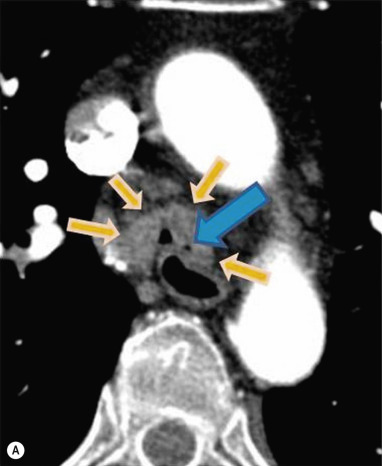
These are uncommon tumours, accounting for less than 1% of all thoracic malignancies. The vast majority are squamous cell carcinoma and adenoid cystic carcinoma ( Fig. 6.3 ). Other neoplasms, such as mucoepidermoid carcinoma, carcinoid tumour ( Fig. 6.4 ), lymphoma, plasmocytoma and adenocarcinoma are rare. On CT, they appear as a soft-tissue mass, usually in the posterior and lateral wall (see Fig. 6.3A ). Often sessile and eccentric, resulting in asymmetric luminal narrowing, they may appear rarely circumferential. They can be polypoid and mostly intraluminal with mediastinal extension representing 30–40%. The surface of tumour is often irregular in squamous cell carcinoma, whereas it is smooth in adenoid cystic carcinoma. Multiplanar reformation and volumetric rendering images are recommended for a precise pre-therapeutic assessment of tumour extent (see Figs 6.3B, 6.4B and D ). These tumours are best treated surgically especially with primary resection and re-anastomosis followed by radiation.
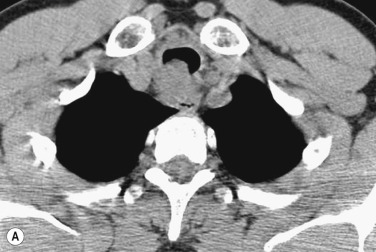
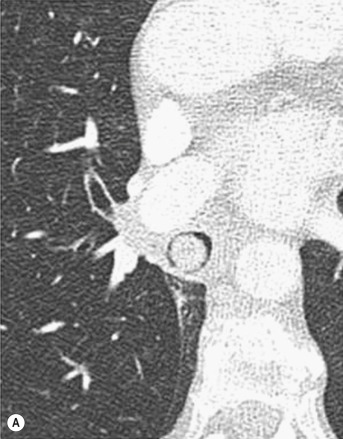
The large airways may be involved secondarily by malignant neoplasms as a result of either haematogenous metastasis or direct invasion from the oesophagus, thyroid, mediastinum or lung. Neoplasms that have a propensity to metastasise to the trachea and major bronchi include renal cell carcinoma and melanoma. On CT, the abnormalities are usually focal and include intraluminal soft-tissue nodules and wall thickening ( Fig. 6.5 ). Distal bronchoceles may also be seen.
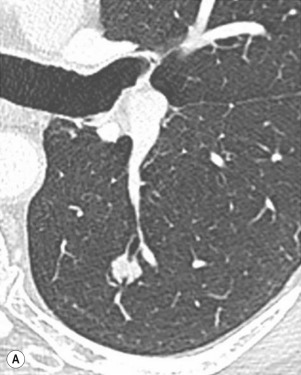
The most common are hamartoma, leiomyoma, neurogenic tumour and lipoma. They are usually well-demarcated, round and less than 2 cm in diameter. The radiologic appearance typically consists of a smoothly marginated intraluminal polyp. Hamartomas and lipomas may demonstrate fat attenuation on CT.
Tracheobronchial papillomatosis is a particular entity caused by human papillomavirus infection usually acquired at birth from an infected mother. The larynx is most commonly affected, with occasional extension into the trachea and proximal. Exceptionally, the infection spreads into the lung parenchyma. The typical radiological findings consist of multiple small nodules projecting into the airway lumen or diffuse nodular thickening of the airway wall. Although benign, papilloma may undergo transformation to squamous cell carcinoma.
Involvement of the large airways is a common manifestation of Wegener granulomatosis. Inflammatory lesions may be present with or without subglottic or bronchial stenosis, ulcerations and pseudotumours. Radiological manifestations include thickening of the subglottic region and proximal trachea with a smooth symmetric or asymmetric narrowing over variable length. Stenosis may also be seen in any main lobar or segmental bronchus. Nodular or polypoid lesions may also be seen on the inner contour of the airway lumen.
Relapsing polychondritis is a rare systemic disease of autoimmune pathogenesis that affects cartilage at various sites, including the ears, nose, joints, and tracheobronchial tree. Histologically, the acute inflammatory infiltrate present in the cartilages and perichondrial tissue induces progressive dissolution and fragmentation of the cartilage followed by fibrosis. Symmetric subglottic stenosis is the most frequent manifestation in the chest. As the disease progresses, the distal trachea and bronchi may be involved. CT shows smooth thickening of the airway wall associated with more or less diffuse narrowing ( Fig. 6.6 ). In the early stage, the posterior wall of the trachea is spared but in advanced disease circumferential wall thickening occurs ( Fig. 6.7 ). The trachea may become flaccid with considerable collapse at expiration. Gross destruction of the cartilaginous rings with fibrosis may cause stenosis.
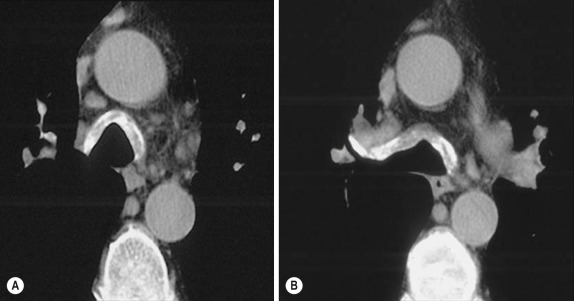
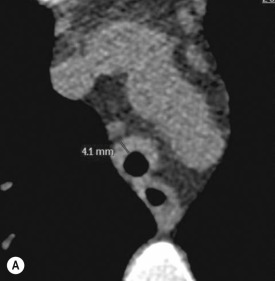
Deposition of amyloid in the trachea and bronchi may be seen in association with systemic amyloidosis or as an isolated manifestation. As a result, the amyloid forms are either multifocal or diffuse submucosal plaques or masses. The overlying mucosa is usually intact. Dystrophic calcification or ossification is frequently present. CT shows focal or, more commonly, diffuse thickening of the airway wall and narrowing of the lumen. Calcification may be seen. Narrowing of the proximal bronchi can lead to distal atelectasis, bronchiectasis, or both, or to obstructive pneumonia.
Involvement of the trachea is rare and when it occurs, it is associated with laryngeal involvement. The proximal and distal parts of the trachea may be affected, and the appearance of the stenosis may be smooth, irregular and nodular, or even mass-like. Bronchial involvement is much more common as a manifestation of sarcoidosis. The most common signs at CT are regular or nodular bronchial wall thickening, reflecting the presence of granulomas and fibrous tissue in the peribronchial interstitium. This bronchial wall thickening may result in smooth or irregular bronchial narrowing, which correlates with the presence of mucosal thickening at bronchoscopy and presumably reflects prominent inflammation in this location. Obstruction of lobar or segmental bronchi may occur as a result of granulomata, airway wall fibrosis, peribronchial lymph node compression and conglomerate fibrosis or some combination of these phenomena. Bronchial stenosis may clear spontaneously or with steroid treatment.
Ulcerative tracheitis and tracheobronchitis are rare complications and occur more often in association with ulcerative colitis than Crohn disease. In most but not all cases, the diagnosis of inflammatory bowel disease precedes the presence of airway disease. Histologically, tracheobronchitis is characterised by chronic inflammation and more or less concentric mucosal and submucosal fibrosis. Ulceration and luminal narrowing may be evident. Cartilaginous plates are not destroyed. On CT, the tracheobronchial walls are thickened and produce irregular luminal narrowing ( Fig. 6.8 ). Bronchial wall thickening and bronchiectasis may also be present with or without mucoïd impaction.
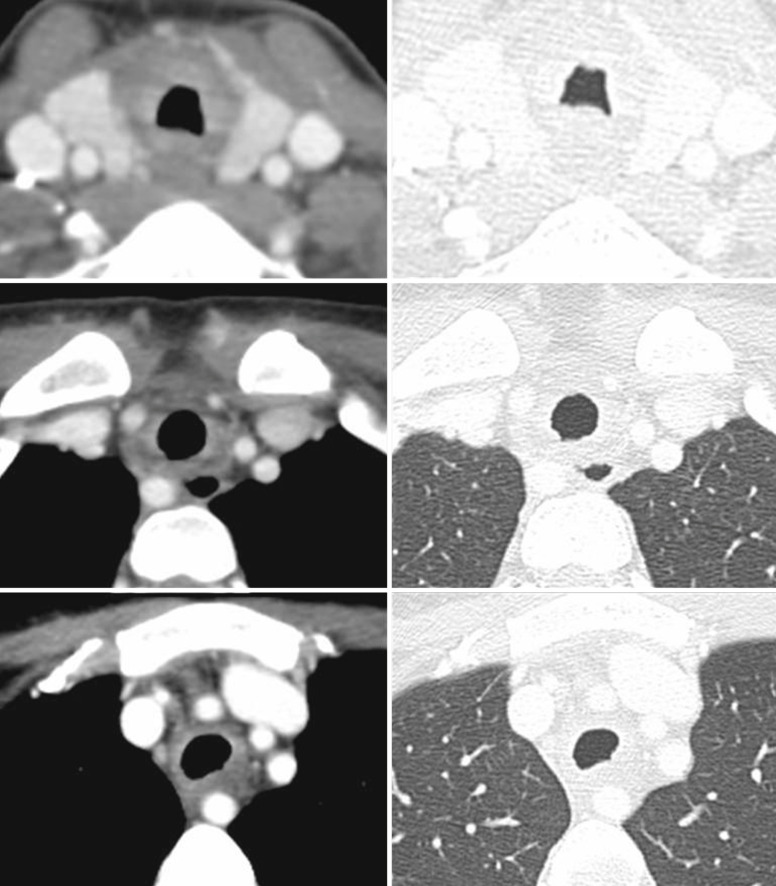
This rare disorder is characterised by the presence of multiple cartilaginous nodules and bony submucosal nodules on the inner surface of the trachea and proximal airways. Men are more frequently involved than women and most patients are more than 50 years of age. Histologically, the nodules contain heterotopic bone, cartilage and calcified acellular protein matrix. The overlying bronchial mucosa is normal and because it contains no cartilage, the posterior wall of the trachea is spared. The chest radiograph may be normal or may demonstrate lobar collapse or infective consolidation. If the tracheal air column is clearly seen, multiple sessile nodules that project into the tracheal lumen extending over a long segment of the trachea can be appreciated. On CT, tracheal cartilages are thickened and show irregular calcifications. The nodules may protrude from the anterior and lateral walls into the lumen; they usually show foci of calcification ( Fig. 6.9 ).
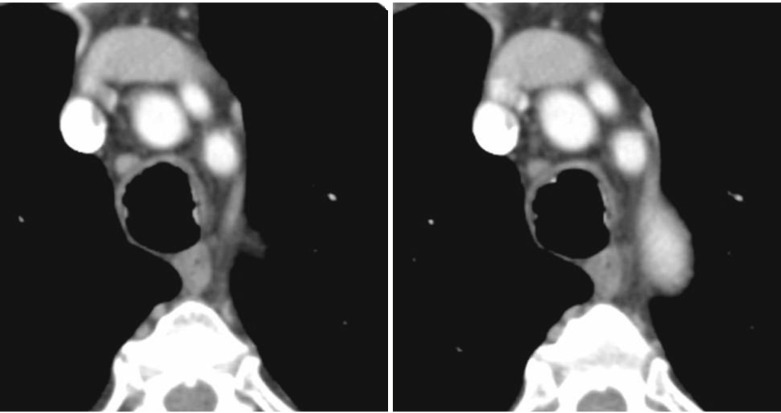
Characterised by a diffuse narrowing involving the intrathoracic trachea, this entity is almost always associated with COPD ( Fig. 6.10 ). The pathogenesis of the lesion is obscure, but probably it is an acquired deformity related to the abnormal pattern and magnitude of intrathoracic pressure changes in COPD. On radiographs and CT, the condition is easily recognised by noting that the internal side-to-side diameter of the trachea is decreased to half or less than the corresponding sagittal diameter. On the postero-anterior radiograph and CT multiplanar reformations, the narrowing usually affects the whole intrathoracic trachea, with an abrupt return to normal calibre at the thoracic inlet (see Fig. 6.10 ). The trachea usually shows a smooth inner margin but occasionally has a nodular contour. Calcification of the tracheal cartilage is frequently evident.
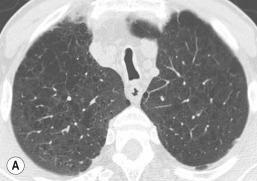
Become a Clinical Tree membership for Full access and enjoy Unlimited articles
If you are a member. Log in here